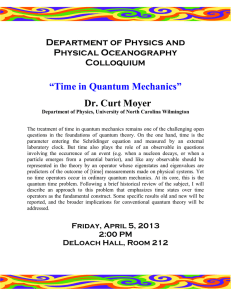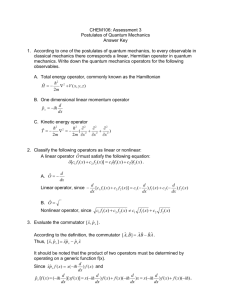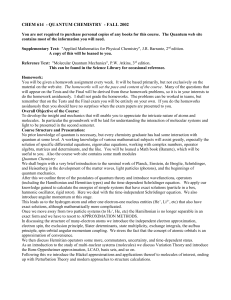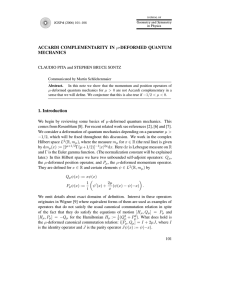Three Pictures of Quantum Mechanics Thomas R. Shafer April 17, 2009
advertisement
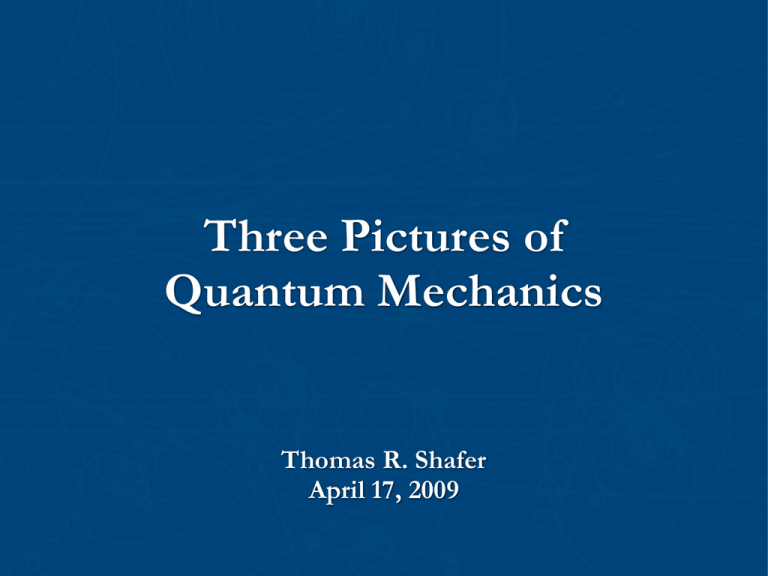
Three Pictures of Quantum Mechanics Thomas R. Shafer April 17, 2009 Outline of the Talk • Brief review of (or introduction to) quantum mechanics. • 3 different viewpoints on calculation. • Schrödinger, Heisenberg, Dirac • A worked-out example calculation. • Other interpretations & methods. Setting the Stage: Quantum Mechanics in Five Minutes The Wave Function • A particle or system is described by its wave function. • The wave function lives in a well-defined space (typically a Hilbert space) described by some set of basis vectors. • The natural language for our discussion is finite-dimensional linear algebra, although this is all valid for other spaces. The Wave Function • The wave function satisfies Schrödinger’s differential equation, which governs the dynamics of the system in time. • The Hamiltonian of the system, , is the operator which describes the total energy of the quantum system. Wave Function Example • Example: An atom with two accessible energetic space. • The space may be completely described by two basis vectors. All possible states of the atom may be expressed as linear combinations of these basis vectors. Wave Function Example , generally. Quantum Statistics • The Copenhagen interpretation of quantum mechanics tells us complex square of the wave function gives the probability density function (PDF) of a quantum system. For the complex square to be meaningful statistically, we need the probabilities to sum to 1. Commutators • In general, two operators do not commute in quantum mechanics. • The commutator measures the difference between the two composite operations. • Example: Canonical Commutation Relation Quantum Statistics • • The probability of an observation is found by computing matrix elements. If a quantum system is in a superposition of states, we find probabilities through inner products. This is just Fourier theory! Three Different Ways to Calculate Early Questions in Quantum Mechanics • Question of Interpretation • What does quantum mechanics mean? • Inherently statistical • Question of Execution • How do we do calculations? • What is a state? How does a state change in time? 3 Different Answers The Three Pictures of Quantum Mechanics Schrödinger Heisenberg Dirac The Three Pictures of Quantum Mechanics • Quantum systems are regarded as wave functions which solve the Schrödinger equation. • Observables are represented by Hermitian operators which act on the wave function. • In the Schrödinger picture, the operators stay fixed while the Schrödinger equation changes the basis with time. Schrödinger The Three Pictures of Quantum Mechanics • In the Heisenberg picture, it is the operators which change in time while the basis of the space remains fixed. • Heisenberg’s matrix mechanics actually came before Schrödinger’s wave mechanics but were too mathematically different to catch on. • A fixed basis is, in some ways, more mathematically pleasing. This formulation also generalizes more easily to relativity - it is the nearest analog to classical physics. Heisenberg The Three Pictures of Quantum Mechanics • In the Dirac (or, interaction) picture, both the basis and the operators carry time-dependence. • The interaction picture allows for operators to act on the state vector at different times and forms the basis for quantum field theory and many other newer methods. Dirac The Schrödinger Picture Ô = ! Ô (t) The Schrödinger Picture • In the Schrödinger picture, the operators are constant while the basis changes is time via the Schrödinger equation. • The differential equation leads to an expression for the wave function. The Schrödinger Picture • A quantum operator as the argument of the exponential function is defined in terms of its power series expansion. • This is how the states pick up their time-dependence. The Heisenberg Picture The Heisenberg Picture • • In the Heisenberg picture, the basis does not change with time. This is accomplished by adding a term to the Schrödinger states to eliminate the time-dependence. The quantum operators, however, do change with time. The Heisenberg Picture • We may define operators in the Heisenberg picture via expectation values. • Operators in the Heisenberg picture, therefore, pick up timedependence through unitary transformations. The Heisenberg Picture • We may ascertain the operators’ time-dependence through differentiation. • The operators are thus governed by a differential equation known as Heisenberg’s equation. The Dirac (Interaction) Picture The Dirac Picture • The Dirac picture is a sort of intermediary between the Schrödinger picture and the Heisenberg picture as both the quantum states and the operators carry time dependence. It is especially useful for problems including explicitly timedependent interaction terms in the Hamiltonian. • Consider some Hamiltonian in the Schrödinger picture containing both a free term and an interaction term. The Dirac Picture • In the interaction picture, state vectors are again defined as transformations of the Schrödinger states. These state vectors are transformed only by the free part of the Hamiltonian. • The Dirac operators are transformed similarly to the Heisenberg operators. The Dirac Picture • Consider the interaction picture counterparts to the Schrödinger Hamiltonian operators. This follows from commuting with itself in the series expansion of the exponential. • The interacting term of the Schrödinger Hamiltonian is defined similarly. The Dirac Picture • States in the interaction picture evolve in time similarly to Heisenberg states… but with a twist. The Dirac Picture • Therefore, the state vectors in the interaction picture evolve in time according to the interaction term only. • It can be easily shown through differentiation that operators in the interaction picture evolve in time according only to the free Hamiltonian. Matrix Elements • Schrödinger Picture • Heisenberg Picture • Dirac Picture Demonstration: The Canonical Commutation Relation Time-Dependent Commutators • Canonical Commutation Relation • Schrödinger Picture Representation Time-Dependent Commutators • Heisenberg & Dirac Pictures (No Interaction) • 1-D Harmonic Oscillator • Operator time-dependence Time-Dependent Commutators • Now have time-dependent commutators. A Worked Example: The Jaynes-Cummings Hamiltonian The Jaynes-Cummings Hamiltonian • • • • Describes an atom in an electromagnetic field. Only two accessible energy levels. Perfectly reflective cavity, no photon loss. Assume zero detuning, i.e. . The Jaynes-Cummings Hamiltonian • Energy contained in the free field. The Jaynes-Cummings Hamiltonian • Energy of the atomic transitions between energy levels. The Jaynes-Cummings Hamiltonian • Interaction energy of the field and the atom itself. The Jaynes-Cummings Hamiltonian • Split the Hamiltonian into two commuting terms. The Jaynes-Cummings Hamiltonian • Initial state is a superposition of photon states. • We assume the atom to be in its excited state. The Schrödinger Picture • • The free Hamiltonian adds only a phase factor! Now expand the interacting term in a power series... The Schrödinger Picture • Cosine plus Sine! The Schrödinger Picture • The fully time-dependent state may now be written. The Schrödinger Picture • We may calculate, for example, the average atomic inversion. The Schrödinger Picture • Expected value for the atomic inversion for mean photon number N = 25 (light blue) and N = 100 (dark blue). The Dirac Picture • Making the unitary transformation leads to wave function dependence only on the interaction term. • Make the same series expansion as before (no phase factors). The Dirac Picture • We need to calculate the time-dependence of the inversion operator to obtain an expectation value. • Everything commutes no time-dependence. The Dirac Picture • The expectation value of the inversion operator gives the same result, as required. Other Interpretations & Forms of Calculation in Quantum Mechanics Summary: Three Pictures & Other Forms • • Methods of Calculation • Schrödinger’s Wave Mechanics • • • • • Heisenberg’s Matrix Mechanics Dirac’s Canonical Quantization Feynman’s Path Integrals / Sum Over Histories Constructive Field Theory QFT in Curved Spacetime Other Notable Interpretations • • Many-Worlds Interpretation Quantum De-coherence Thank You! References • E. Jaynes and F. W. Cummings, Proceedings of the IEEE 51, • C. C. Gerry and P. L. Knight, Introductory Quantum Optics 89 (1963) • P. A. M. Dirac, The Principles of Quantum Mechanics, 4th ed. • D. J. Gri!ths, Introduction to Quantum Mechanics, 2nd ed. • http://en.wikipedia.org/wiki/Schrödinger_picture • http://en.wikipedia.org/wiki/Heisenberg_picture • http://en.wikipedia.org/wiki/Interaction_picture • http://en.wikipedia.org/wiki/ Mathematical_formulation_of_quantum_mechanics • T. Shafer, Collapse and Revival in the Jaynes-Cummings-Paul Model

